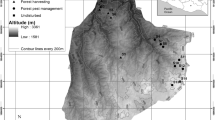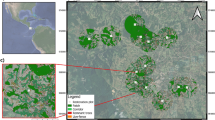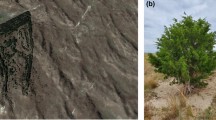Abstract
Abandoned tropical pastures offer opportunities for passive and active restoration of native forest communities. Tree architecture of remnant canopy trees may be one important factor that can facilitate native plant recruitment in abandoned pastures but has largely been overlooked. Here, we evaluated patterns of native woody plant recruitment under remnant trees in abandoned pastures on Hawai’i Island and how these might be related to both tree architectural features and landscape variables. We measured native woody stems (excluding sprouts of the tree itself) in a 5 m radius around the base of each tree and modeled total basal area of native stems as a function of tree architectural characteristics. Recruitment was positively correlated with tree height as well as horizontal woody area below 1 m (tree structure that occurred below 1 m and was < 45° angle from the ground) around the base of trees. Tall trees likely attract more avian seed dispersers due to their higher visibility on the landscape and increased crown volume. Horizontal woody area likely provides establishment microsites that are above the pasture grass layer, similar to how dead or decaying logs act as nurse substrates. Unlike previous studies, we found little evidence that landscape variables such as distance to the intact forest or nearest canopy neighbor influenced understory recruitment. Tree architectural characteristics can be important predictors of native plant recruitment in abandoned tropical pastures and should be considered in addition to local and landscape-level variables.


Similar content being viewed by others
References
Archibald S, Bond WJ (2003) Growing tall vs growing wide: tree architecture and allometry of Acacia karroo in forest, savanna, and arid environments. Oikos 102:3–14
Atkinson CT, LaPointe DA (2009) Introduced avian diseases, climate change, and the future of Hawaiian honeycreepers. J Avian Med Surg 23:53–63
Benning TL, LaPointe D, Atkinson CT, Vitousek PM (2002) Interactions of climate change with biological invasions and land use in the Hawaiian Islands: modeling the fate of endemic birds using a geographic information system. Proc Natl Acad Sci 99:14246–14249
Berens DG, Farwig N, Schaab G, Böhning-Gaese K (2008) Exotic guavas are foci of forest regeneration in Kenyan farmland. Biotropica 40:104–112
Berger A (1981) Hawaiian birdlife. University of Hawai’i Press, Honolulu
Burnham KP, Anderson DR (2002) Model selection and multimodel inference. Springer-Verlag, New York
Calcagno V (2013) glmulti: model selection and multimodel inference made easy. R package Version 1:67
Chazdon RL (2014) Second growth: the promise of tropical forest regeneration in an age of deforestation. Univesity of Chicago Press, Chicago
Cole RJ, Holl KD, Zahawi RA (2010) Seed rain under tree islands planted to restore degraded lands in a tropical agricultural landscape. Ecol Appl 20:1255–1269
Cole RJ, Litton CM (2014) Vegetation response to removal of non-native feral pigs from Hawaiian tropical montane wet forest. Biol Invas 16:125–140
Denslow JS, Uowolo AL, Flint Hughes R (2006) Limitations to seedling establishment in a mesic Hawaiian forest. Oecologia 148:118–128
Drake DR, Pratt LW (2001) Seedling mortality in Hawaiian rain forest: the role of small-scale physical disturbance. Biotropica 33:319–323
Duncan RS, Chapman CA (1999) Seed dispersal and potential forest succession in abandone agriculture in tropical Africa. Ecol Appl 9:998–1008
Giambelluca TW, Chen Q, Frazier AG, Price JP, Chen Y-L, Chu P-S, Eischeid JK, Delparte DM (2013) Online rainfall atlas of Hawai’i. Bull Am Meteorol Soc 94:313–316
Guariguata MR, Ostertag R (2001) Neotropical secondary forest succession: changes in structural and functional characteristics. For Ecol Manag 148:185–206
Guevara S, Laborde J (1993) Monitoring seed dispersal at isolated standing trees in tropical pastures: consequences for local species availability. Plant Ecol 107–108:319–338
Guevara S, Laborde J, Sánchez-Rios G (2004) Rain forest regeneration beneath the canopy of fig trees isolated in pastures of Los Tuxtlas, Mexico. Biotropica 36:99–108
Guevara S, Purata SE, Maarel E (1986) The role of remnant forest trees in tropical secondary succession. Plant Ecol 66:77–84
Harrison RD (2005) Figs and the diversity of tropical rainforests. Bioscience 55:1053–1064
Hodges, C., Adee, K., Stein, J., Wood, H., Doty, R. (1986) Decline of Ohia (Metrosideros polymorpha) in Hawaii: a review. General Technical Report PSW-86. Berkeley, California
Holl KD (1999) Factors limiting tropical rain forest regeneration in abandoned pasture: seed rain, seed germination, microclimate and soil. Biotropica 31:229–242
Holl KD, Loik ME, Lin EHV, Samuels IA (2000) Tropical montane forest restoration in Costa Rica: overcoming barriers to dispersal and establishment. Restor Ecol 8:339–349
Jeffrey J, Horiuchi B (2003) Tree planting at Hakalau Forest National Wildlife Refuge - the right tool for the right stock type. Native Plant J 4:30–31
Jones ER, Wishnie MH, Deago J, Sautu A, Cerezo A (2004) Facilitating natural regeneration in Saccharum spontaneum (L.) grasslands within the Panama Canal Watershed: effects of tree species and tree structure on vegetation recruitment patterns. For Ecol Manag 191:171–183
Longman RJ, Diaz HF, Giambelluca TW (2015) Sustained increases in lower-tropospheric subsidence over the central tropical north Pacific drive a decline in high-elevation rainfall in Hawaii. J Clim 28:8743–8759
Mueller-Dombois D, Fosberg FR (1998) Vegetation of the tropical Pacific Islands. Springer-Verlag, New York
Paxton EH, Yelenik SG, Borneman TE, Rose ET, Camp RJ, Kendall SJ (2018) Rapid colonization of a Hawaiian restoration forest by a diverse avian community. Restor Ecol 26:165–173
Peterson CJ, Dosch JJ, Carson WP (2014) Pasture succession in the Neotropics: extending the nucleation hypothesis into a matrix discontinuity hypothesis. Oecologia 175:1325–1335
Peterson CJ, Haines BL (2000) Early successional patterns and potential facilitation of woody plant colonization by rotting logs in premontane Costa Rican pastures. Restor Ecol 8:361–369
Pizo MA, dos Santos BTP (2011) Frugivory, post-feeding flights of frugivorous birds and the movement of seeds in a Brazilian fragmented landscape. Biotropica 43:335–342
Poorter L, Bongers F, Sterck FJ, Wöll H (2003) Architecture of 53 rain forest tree species differeing in adult stature and shade tolerance. Ecology 84:602–608
Rehm EM, Feeley KJ (2015) Freezing temperatures as a limit to forest recruitment above tropical Andean treelines. Ecology 96:1856–1865
Rehm EM, Thomas M, Yelenik S, Bouck D, D'Antonio C (2019) Bryophyte abundance, composition and importance to woody plant recruitment in natural and restoration forests. For Ecol Manag 444:405–413
Rhoades CC, Eckert GE, Coleman DC (1998) Effect of pasture trees on soil nitrogen and organic matter: implications for tropical montane forest restoration. Restor Ecol 6:262–270
Santiago LS (2000) Use of coarse woody debris by the plant community of a Hawaiian montane cloud forest. Biotropica 32:633–641
Scowcroft PG (1992) Role of decaying logs and other organic seedbeds in natural regeneration of Hawaiian forest species on abandoned montane pasture
Slocum MG (2001) How tree species differ as recruitment foci in a tropical pasture. Ecology 82:2547–2559
Slocum MG (2000) Logs and fern patches as recruitment sites in a tropical pasture. Restor Ecol 8:408–413
Slocum MG, Horvitz CC (2000) Seed arrival under different genera of trees in a neotropical pasture. Plant Ecol 149:51–62
Toh I, Gillespie M, Lamb D (1999) The role of isolated trees in facilitating tree seedling recruitment at a degraded sub-tropical rainforest site. Restor Ecol 7:288–297
Van Riper C, Scott JM (1979) Observations on distribution, diet, and breeding of the Hawaiian Thrush. Condor 81:65–71
Willson MF, Crome FHJ (1989) Patterns of seed rain at the edge of a tropical Queensland rain forest. J Trop Ecol 5:301–308
Yelenik SG (2017) Linking dominant Hawaiian tree species to understory development in recovering pastures via impacts on soils and litter. Restor Ecol 25:42–52
Zahawi RA, Augspurger CK (2006) Tropical forest restoration: tree islands as recruitment foci in degraded lands of Honduras. Ecol Appl 16:464–478
Zahawi RA, Holl KD, Cole RJ, Reid JL (2013) Testing applied nucleation as a strategy to facilitate tropical forest recovery. J Appl Ecol 50:88–96
Acknowledgements
The research was funded by NSF DEB 1557177 and REU supplement 1720982. We thank S. Schoepflin, C. Elgersma, A. Egbert, and D. Bouck for field assistance and the Hakalau Forest National Wildlife Refuge for site access. Any use of trade, firm, or product names is for descriptive purposes only and does not imply endorsement by the U.S. Government.
Author information
Authors and Affiliations
Corresponding author
Additional information
Communicated by Harmony J Dalgleish.
Publisher's Note
Springer Nature remains neutral with regard to jurisdictional claims in published maps and institutional affiliations.
Rights and permissions
About this article
Cite this article
Rehm, E.M., Yelenik, S.G., Smith, M.P. et al. Architecture of remnant trees influences native woody plant recruitment in abandoned Hawaiian pastures. Plant Ecol 222, 659–667 (2021). https://doi.org/10.1007/s11258-020-01072-7
Received:
Accepted:
Published:
Issue Date:
DOI: https://doi.org/10.1007/s11258-020-01072-7




